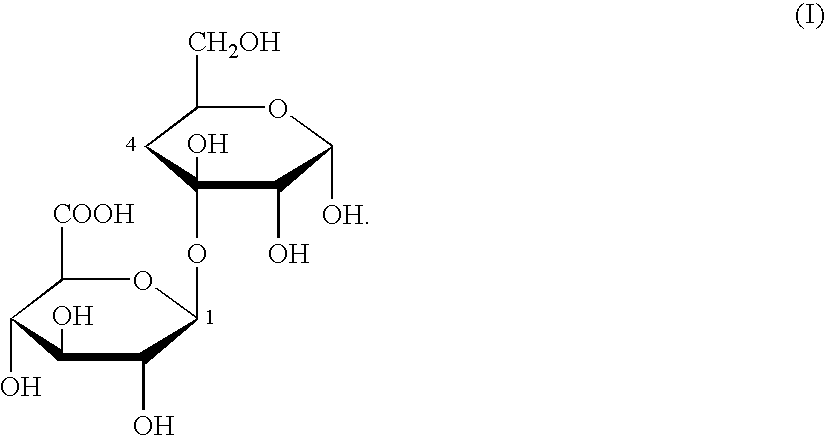Fungal beta-glucuronidase genes and gene products
a technology of beta-glucuronidase and gene products, applied in the field of glucuronidase, can solve the problems of inefficiency of methods, small proportion of cells actually becoming transformed, and neither of the genes has undergone biosafety testing
- Summary
- Abstract
- Description
- Claims
- Application Information
AI Technical Summary
Benefits of technology
Problems solved by technology
Method used
Image
Examples
example 1
Identification of Fungi Expressing β-Glucuronidase
[0126]In this example, fungi are screened for expression of β-glucuronidase by a colorimetric assay. Blue-staining fungi are selected, purified, and identified by comparison of rRNA sequences to known sequences.
[0127]Soil samples from around Canberra, Australia, are shaken for 15 sec in 500 μL of sterile water. After centrifugation at 17,000×g for 15 s, 100 μL of the supernatant are plated on modified M9 medium containing 4-O-(β-D-glucuronyl)-D-glucose (cellobiouronic acid; Cba) as the sole carbon source and 5-bromo-4-chloro-3-indolyl-β-D-glucuronide (X-GlcA) as an indicator substrate for β-glucuronidases (1.28% Na2HPO4.7H2O, 0.3% KH2PO4, 0.05% NaCl, 0.1% NH4Cl, 2 mM MgSO4, 0.1 mM CaCl2, 20 μg L−1 folic acid, 20 μL-1 biotin, 50 μg L−1 nicotinic acid, 50 μg L−1 riboflavin, 50 μg L−1 thiamin.Cl, 0.1 mg L−1 pyridoxine.Cl, 2.8 mg L−1 H3BO3, 1.8 mg L−1 MnCl2.4H2O, 1.4 mg L−1 FeSO4.7H2O, 30 μg L−1 CuCl2.2H2O, 20 μg L−1 CoCl2.6H2O, 3 mg L−1...
example 2
Biochemical Confirmation of β-Glucuronidase Activity in Fungi
[0136]In this example, enzyme activity of β-glucuronidase in fungi is quantified following growth in media containing different inducers or no inducer of expression.
[0137]GUS-expressing fungi are isolated based on their ability to hydrolyze X-GlcA, a widely used GUS substrate. To confirm β-glucuronidase activity, the hydrolysis of 4-methylumbelliferyl-β-D-glucuronide (MU-GlcA), another widely used GUS substrate, is measured in vitro. Both purified fungal isolates are grown in liquid YPD medium on a shaker at 200 rpm / 29° C. for 3 days. Hyphal aggregates are then vacuum-filtered, washed once with modified M9 medium lacking Cba (see Example 1), and suspended in the same medium. After 6 h of starvation in this medium, putative inducers of β-glucuronidase activity are added. These include X-GlcA (0.1 mM), Cba (20 mM) and glucuronic acid (GlcA; 0.1 and 20 mM). The fungi are then incubated in these media for an additional 6 h, in...
example 3
Cloning of Fungal Gus Genes
[0140]Isolated genomic DNA from three fungal isolates is used as a template to amplify fragments of gus genes using degenerate primers. These primers are designed based on a multiple alignment of known gus genes from bacteria and animals. They are predicted to amplify a 1.2 kb-long fragment of an intron-less gene. The sequences of the primers are given in Table 4. PCR amplification is carried out in 20 μL of 10 mM Tris (pH 8.3), 50 mM KCl, 1.5 mM MgCl2, 0.25 μM dNTPs, 11 M gus-fwd+T3, 1 μM gus-rev+T7, containing 0.5 U of REDTaq (Sigma; St. Louis, Mo., USA) and 50 ng of genomic DNA. Cycling conditions are 94° C. (2 min), followed by 35 cycles of 94° C. (20 sec), 48° C. (40 sec) and 72° C. (2 min 30 sec), and a final extension at 72° C. for 7 min.
[0141]
TABLE 4Degenerate primers used to amplify a 1.2 kbfragment of fungal gus genes.*PrimerNo. of basesSequencegus − fwd + T3395′-AATTAACCCTCACTAAAGGGAYTTYTWYAAYTAYGCIGG(SEQ ID NO: 32)gus − rev + T7395′-GTAATACGACT...
PUM
| Property | Measurement | Unit |
|---|---|---|
| Tm | aaaaa | aaaaa |
| Tm | aaaaa | aaaaa |
| Tm | aaaaa | aaaaa |
Abstract
Description
Claims
Application Information
 Login to View More
Login to View More - R&D
- Intellectual Property
- Life Sciences
- Materials
- Tech Scout
- Unparalleled Data Quality
- Higher Quality Content
- 60% Fewer Hallucinations
Browse by: Latest US Patents, China's latest patents, Technical Efficacy Thesaurus, Application Domain, Technology Topic, Popular Technical Reports.
© 2025 PatSnap. All rights reserved.Legal|Privacy policy|Modern Slavery Act Transparency Statement|Sitemap|About US| Contact US: help@patsnap.com



